Get dinner on the table in just 30 minutes with this easy, authentic Beef Pad See Ew! Tender marinated beef, chewy-silky rice noodles, and a sweet-savory sauce all come together in a sizzling stir-fry that brings real Thai flavor straight to your plate.
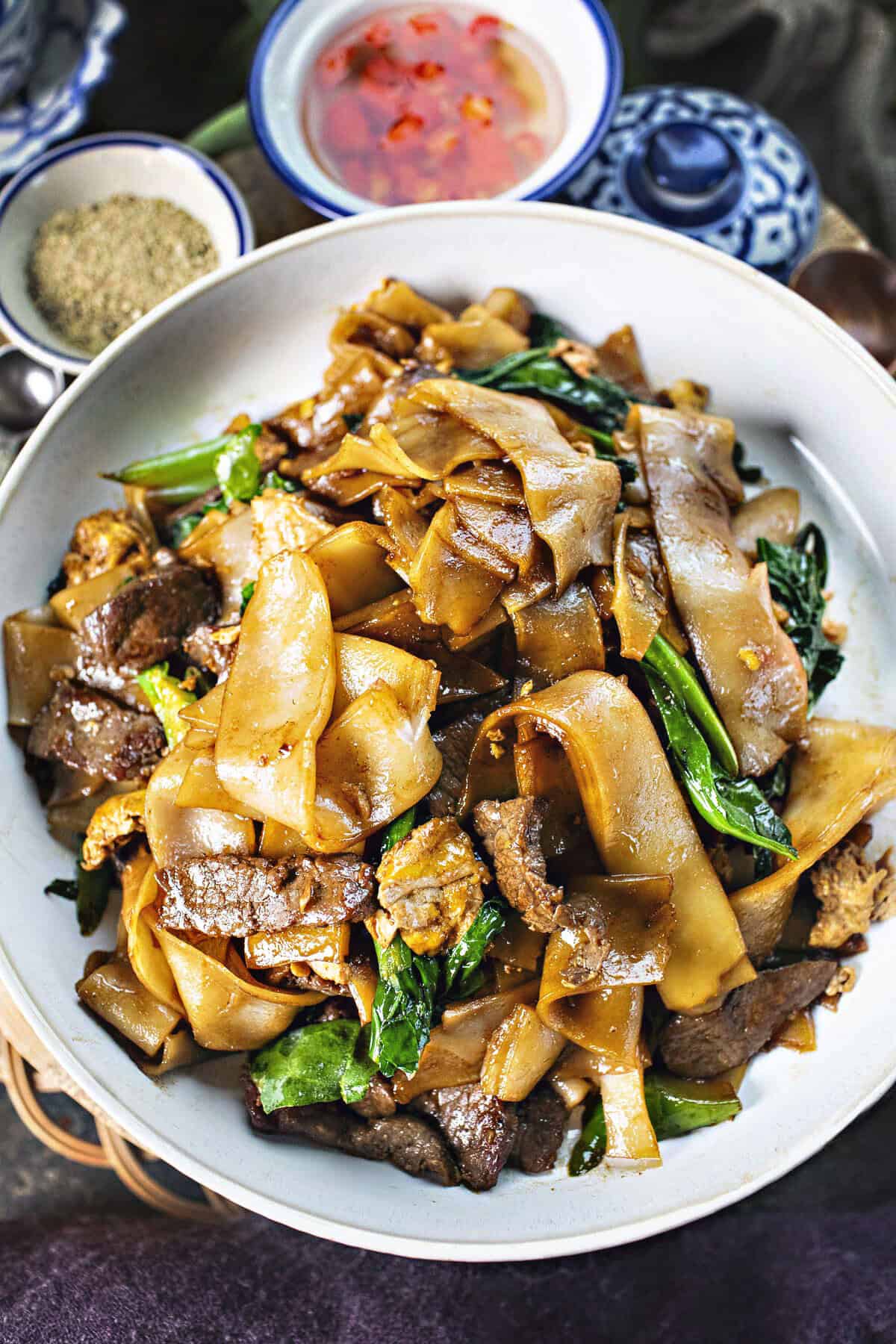
Kick things up a notch by making your own rice noodles or Sen Yai (wide noodles) with my easy recipe! If you love Thai stir-fries, don’t miss Pad Kee Mao-drunken noodles, chicken Pad See Ew, shrimp Pad Thai, Pad Mee Korat, and vegan Pad Thai.
Jump to:
- What is Pad See Ew?
- Why You’ll Love Beef Pad See Ew
- Easy Beef Pad See Ew Ingredients
- A Note About Thai vs. Chinese Soy Sauces
- How to Make Beef Pad See Ew
- How to Serve Beef Pad See Ew
- Kitchen Tips
- Storing Leftovers
- More Thai Recipes You'll Love
- Frequently Asked Questions
- More Thai Rice Noodles Recipes
- Easy Beef Pad See Ew Recipe
I’ve spent years cooking Thai dishes in both Thailand and the U.S., so trust me, beef Pad See Ew can be a breeze—even for beginners. Growing up in Thailand, I learned authentic techniques from family traditions and street vendors. After moving to the U.S., I spent years adapting those recipes for home cooks seeking that signature Thai flavor—without the hassle of hard-to-find ingredients. Ready to get dinner rolling?
What is Pad See Ew?
Pad See Ew is a popular Thai stir fry and one of Thailand’s most beloved noodle dishes, often served at street vendors and bustling markets. This classic Thai dish combines chewy rice noodles seasoned with various soy sauces and tender protein of choice (usually beef, chicken, or shrimp) with Chinese broccoli.
The secret to a great Pad See Ew is cooking over hot oil at high heat to achieve wok hei, a signature chargrilled flavor that gives this authentic Pad See Ew its irresistible smokey-charred taste.
Why You’ll Love Beef Pad See Ew
- Authentic Taste with Simple Ingredients: Experience a true Thai recipe with easy-to-find ingredients and a straightforward cooking process.
- Easy and Fast: Quick to prepare, making it ideal for weeknight dinners or any time you crave a popular street food favorite.
- Adaptable Protein: Swap out beef for chicken, pork, shrimp, or tofu to suit your preference.
- Great as a One-Dish Meal or Family-Style Dinner: Enjoy this iconic Thai street food solo or share it with loved ones for a taste of Thailand at home.
Easy Beef Pad See Ew Ingredients
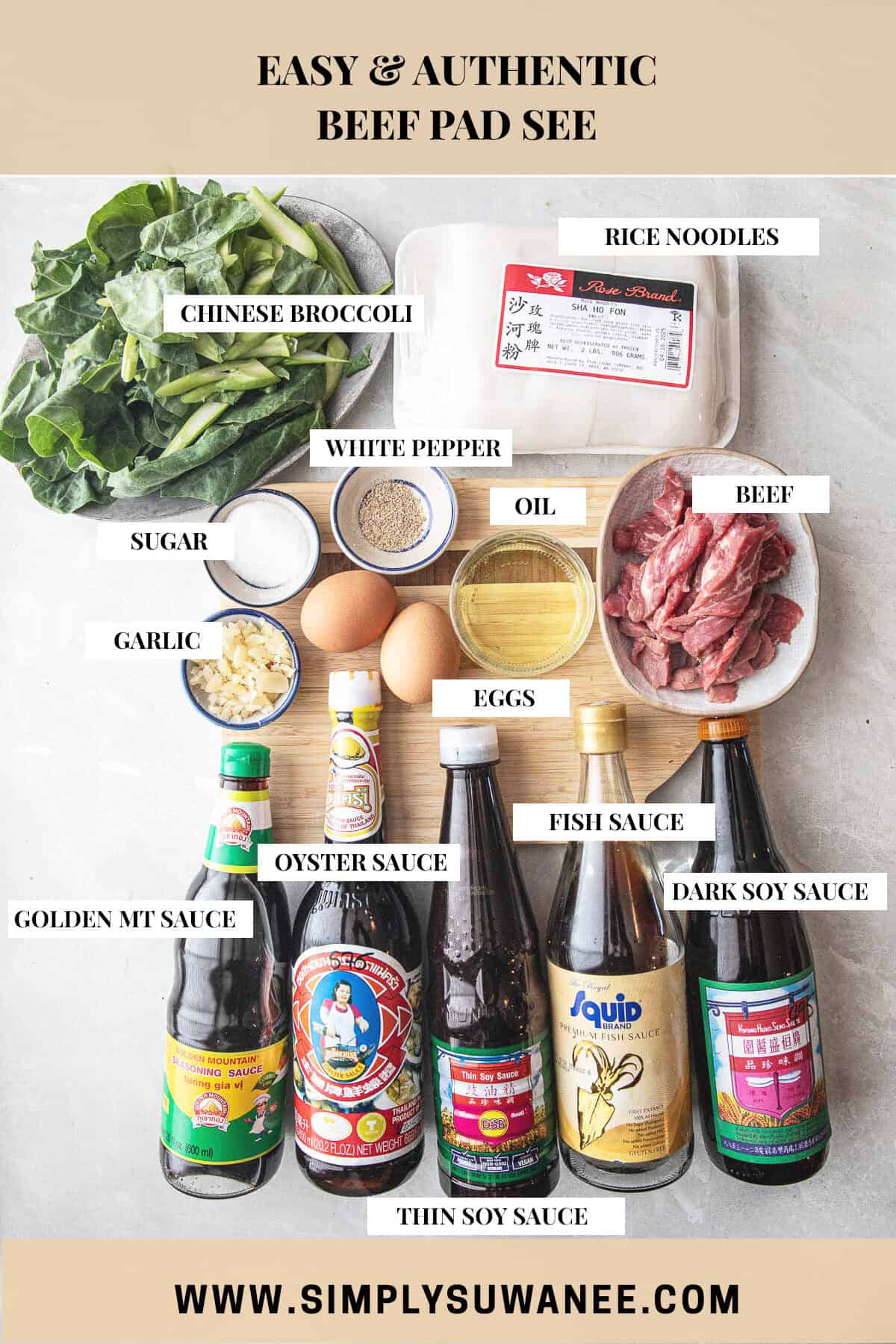
- Wide Rice Noodles: These noodles are essential for achieving an authentic texture and holding up during stir-frying. They can be found in the refrigerator section of the Asian market. They come in a large folded sheet. (See image of the package in the ingredient shot above.) Read more about different types of Thai noodles here.
- Stir Frying Beef. Thinly sliced beef like flank steak makes for quick cooking and tenderness.
- Chinese Broccoli (Gai Lan): Traditional Pad See Ew uses Chinese broccoli, known for its mildly bitter, earthy flavor with peppery, nutty notes. The tender leaves and crisp stems pair perfectly with the savory soy-based sauces in this dish. Look for it at your local Asian market.
- Garlic: Brings bold, aromatic flavor that enhances the savory depth of the dish. Don’t be shy—use plenty of fresh garlic in your stir-fry for the best taste!
- Oil: Use a neutral oil for stir-frying, such as vegetable, avocado, rice bran, or canola oil.
- Thai Oyster Sauce: Provides a rich, umami flavor that binds the ingredients together.
- Light Soy Sauce: Essential for the salty, savory base of the sauce mixture. Regular soy sauce will work if Thai brands are not available.
- Thai Black Soy Sauce: Adds a deeper color and slightly sweeter flavor to the dish. Find these at the Asian grocery store.
- Golden Mountain Sauce: This Thai sauce enhances the overall flavor with its unique taste and extra flavor. Use Maggi sauce as a substitute.
- Fish Sauce: Introduces a subtle seafood umami note, balancing the sweetness and saltiness. Read more about the different types of sauces here.
- Sugar: Balances the savory elements of the different types of soy sauces with a touch of sweetness. Use white or brown sugar.
- Ground White Pepper: Adds mild heat and a subtle pungency without overpowering the dish.
- Chili Vinegar or Prik Nam Som: A simple pickling of Thai chili in rice vinegar called Nam Som Prik Dong. Use it as a table garnish to add a tint of tanginess and spiciness to the stir fry.
- Optional: Ground chili flakes for added heat!
A Note About Thai vs. Chinese Soy Sauces
To get the most authentic Thai flavor in this dish, it's important to use Thai soy sauces—especially the dark soy. Thai dark soy sauce is sweeter, lighter in color, and less salty than Chinese black soy sauce, which tends to be thicker, smokier, and much saltier.
If you’re using a Chinese black soy sauce instead, start with half the amount listed in this recipe and adjust to taste. Too much can overpower the dish and darken the noodles more than intended.
See the image below for the Thai brand I recommend, available at most Asian markets.
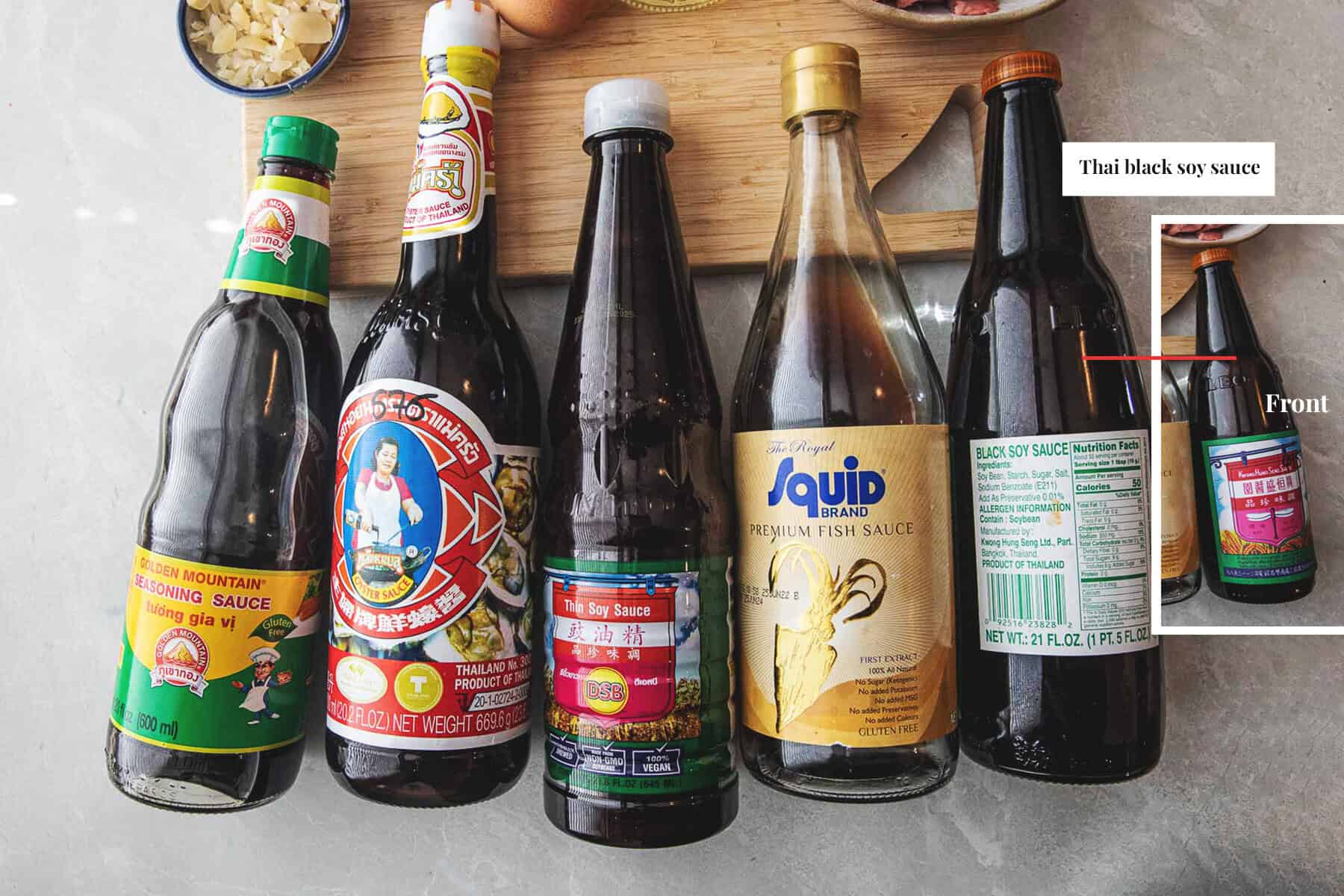
How to Make Beef Pad See Ew
1. Make the Sauce. In a small bowl, mix all the sauces (soy sauce, black soy sauce, oyster sauce, Golden Mountain and fish sauce), sugar, and ground white pepper. Stir well and set aside.
2. Marinate the Beef. Slice beef into thin, long strips. Add 1 tablespoon of the prepared sauce above, massage it into the beef, and let it rest while you prep the other ingredients.
1. Make the Sauce. In a small bowl, mix oyster sauce, light soy, dark soy, Golden Mountain sauce, fish sauce, sugar, and white pepper. Stir well and set aside.
2. Marinate the Beef. Place sliced beef in a bowl and add 1½ tablespoons of the prepared sauce. Mix well and set aside to marinate while you prep the rest.
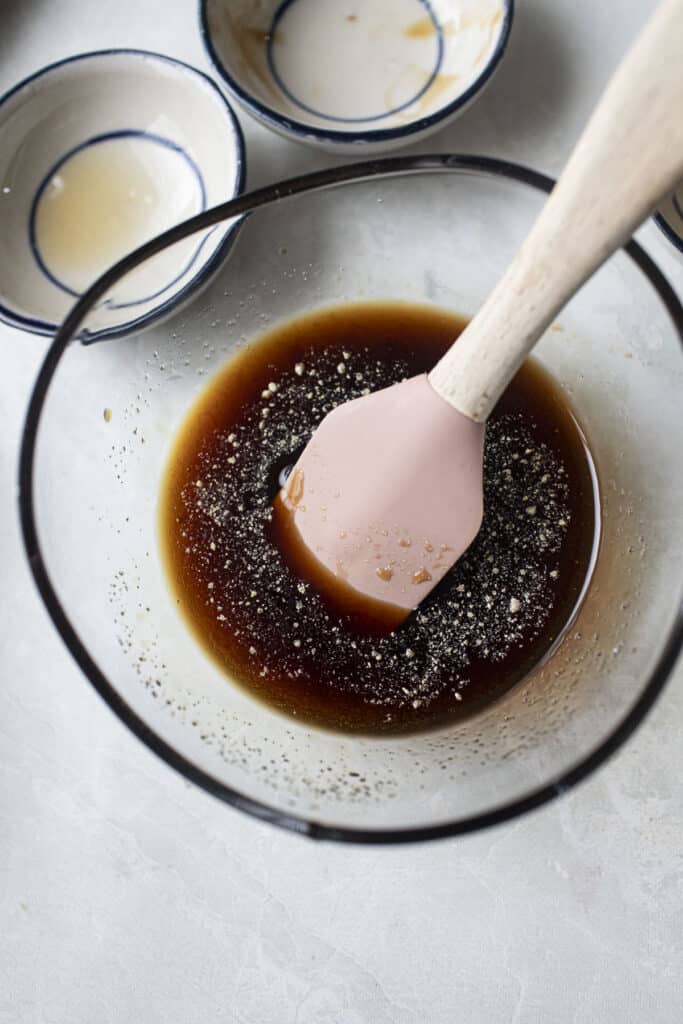
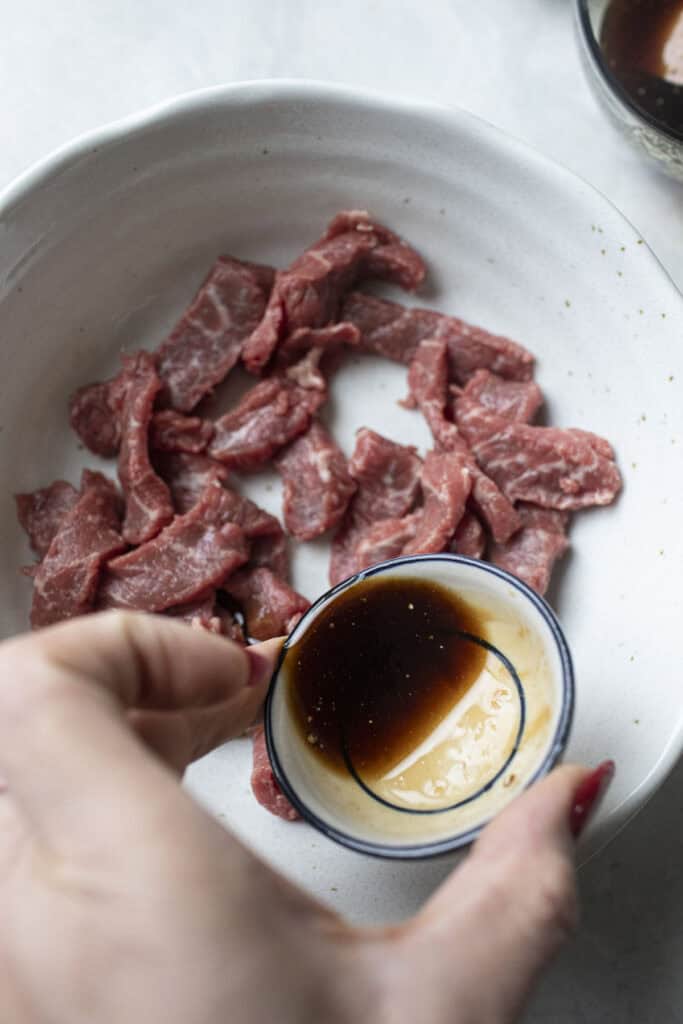
3. Prepare the Noodles
- If using fresh wide rice noodles: Cut into 2-inch strips, then microwave for 2–3 minutes to soften. Gently separate while warm.
- If using dry rice noodles: Soak in hot water until just pliable (or follow package directions), then drain and set aside.
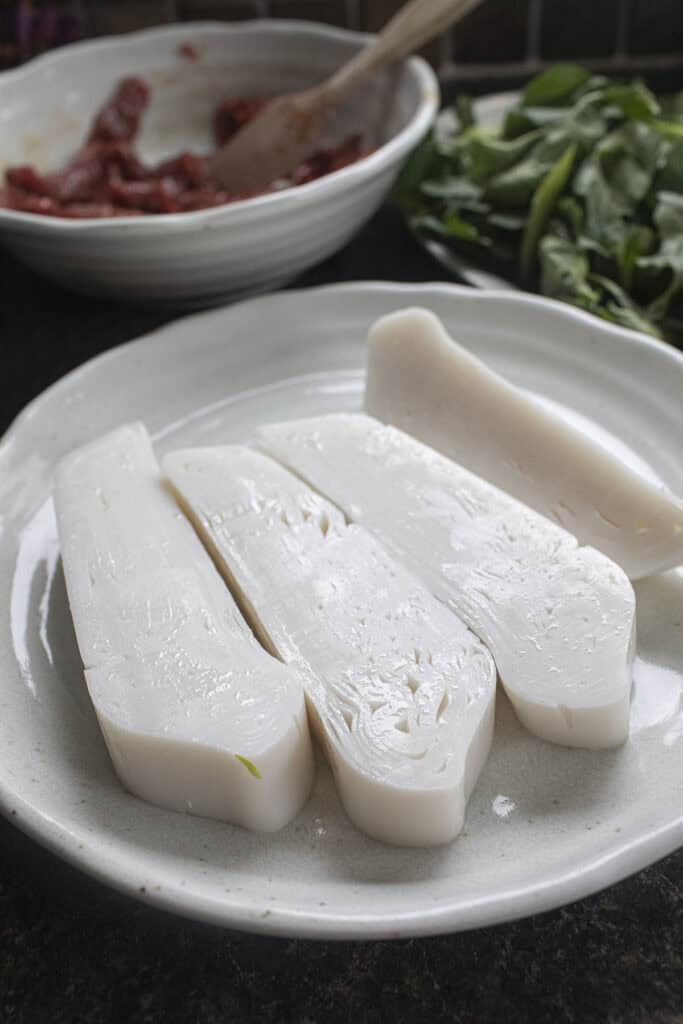
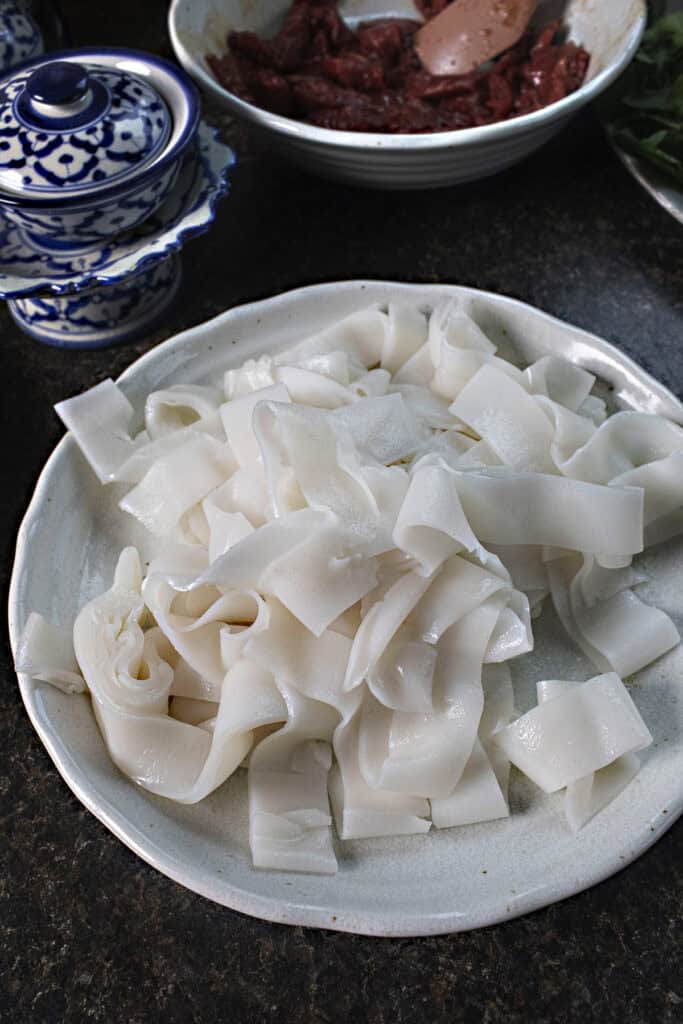
4. Stir-Fry the Beef. Heat 1 tablespoon of oil in a wok over medium-high heat. Add garlic and stir-fry for 10 seconds, then add the beef. Cook for 1 minute—some pink is fine, as it will finish cooking with the other ingredients.
5. Add the Eggs. Push the beef to one side and create a small space in the pan. Add 1 more tablespoon of oil, then crack in two eggs. Scramble gently until softly set.
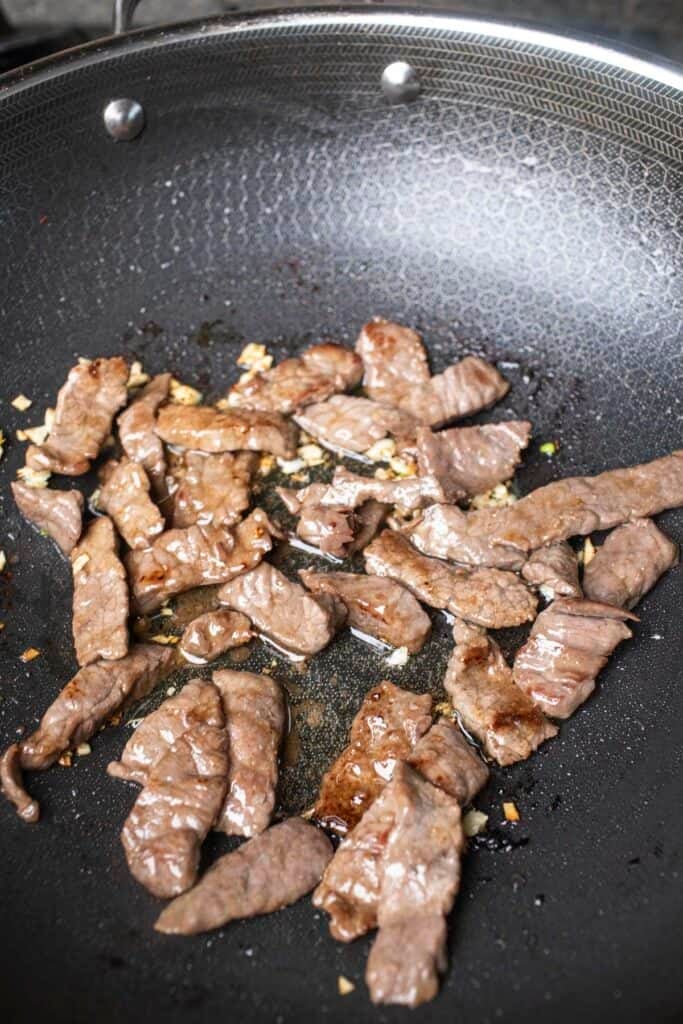
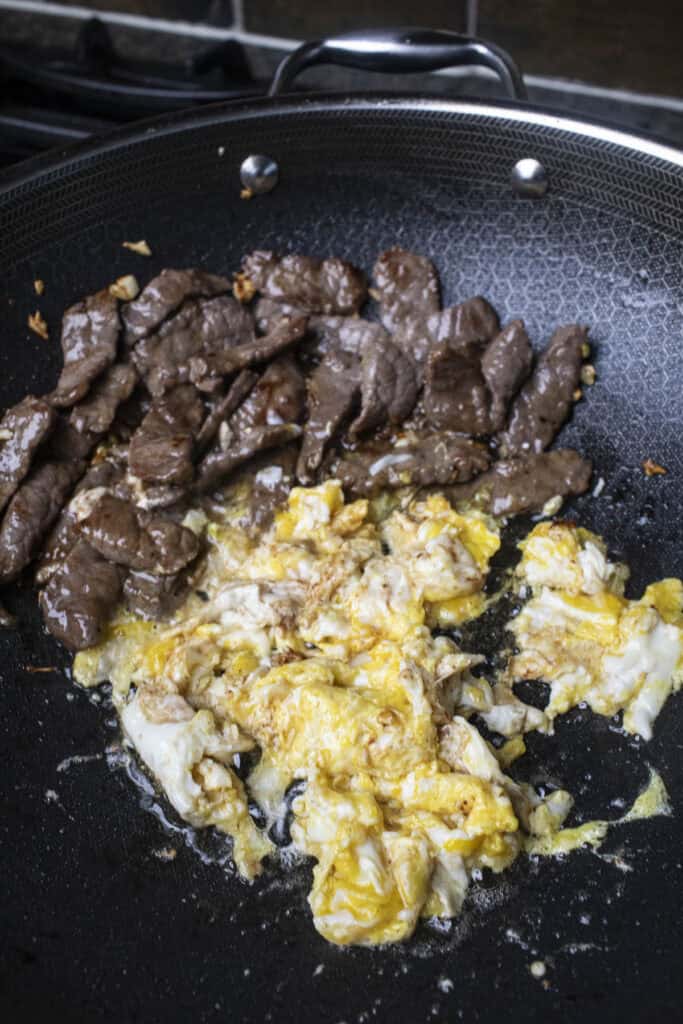
6. Add the Greens. Add the Chinese broccoli, toss well, and cook until just tender, about 60–90 seconds. The leafy parts will wilt quickly.
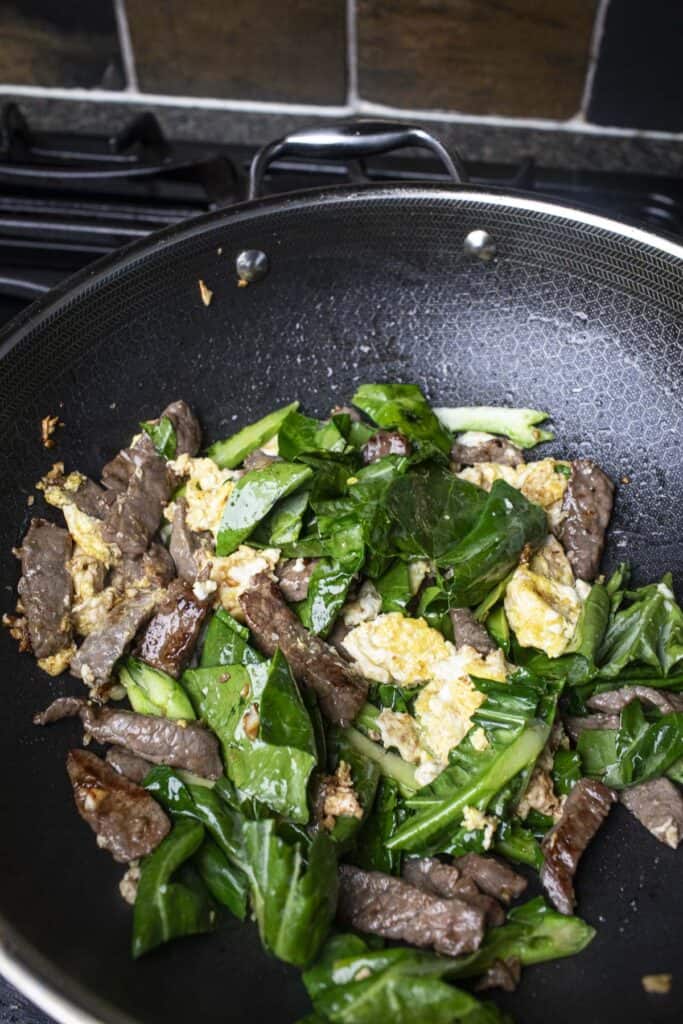
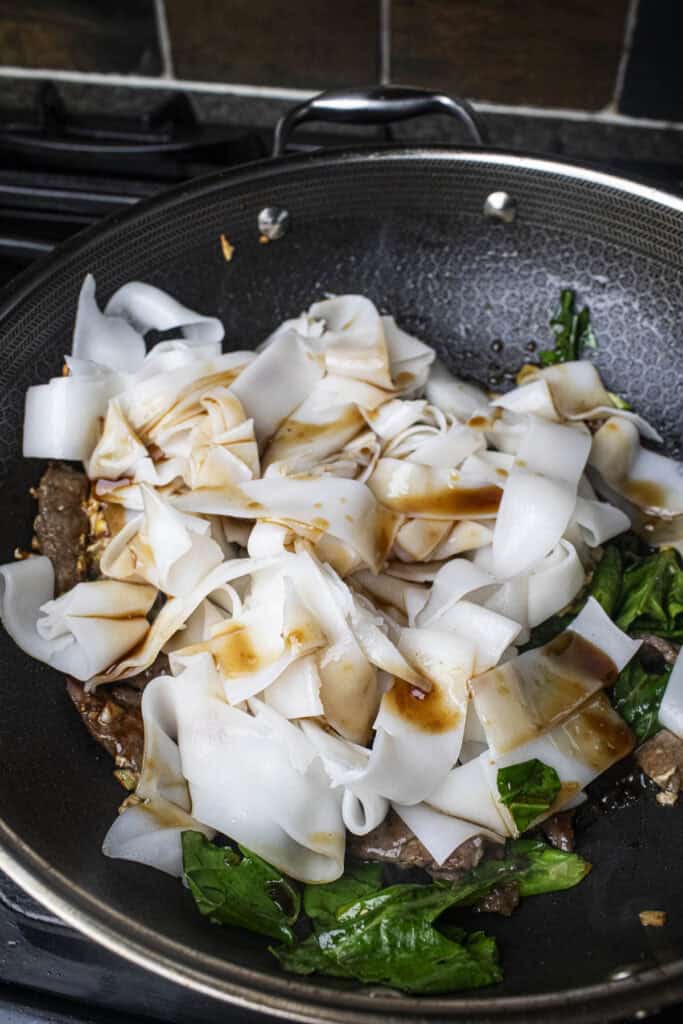
7. Toss in the Noodles and Sauce. Toss in the noodles, then pour in the remaining sauce. Stir-fry over high heat until the noodles are evenly coated and develop a slight char for that signature wok hei flavor.
8. Finish & Serve. Toss in bean sprouts and green onions briefly, then serve hot. Garnish with extra green onions, if desired. Enjoy!
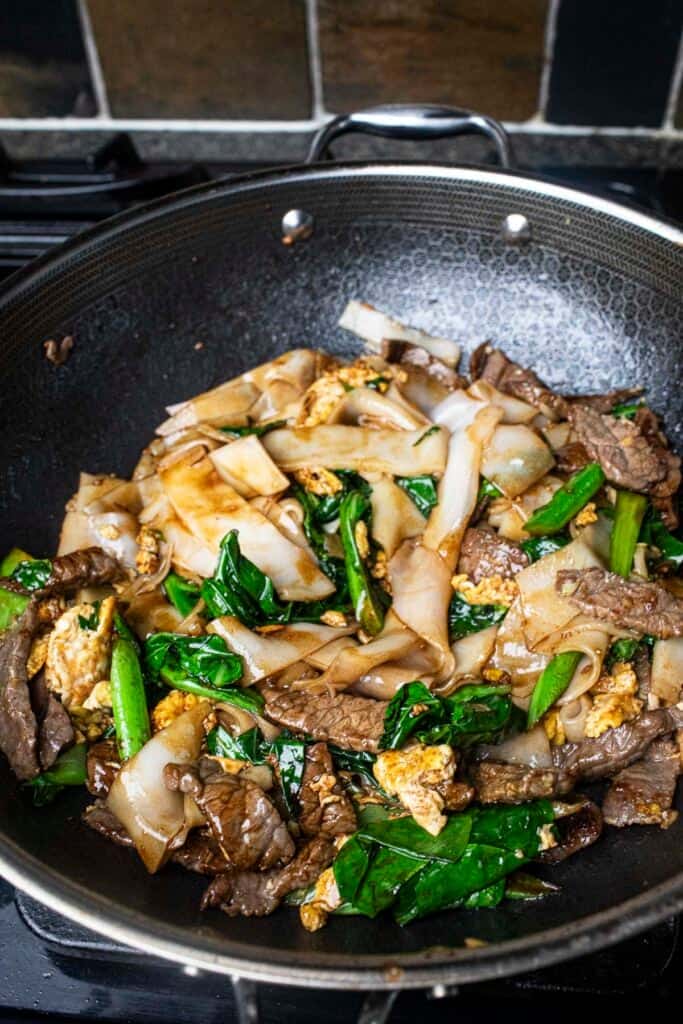
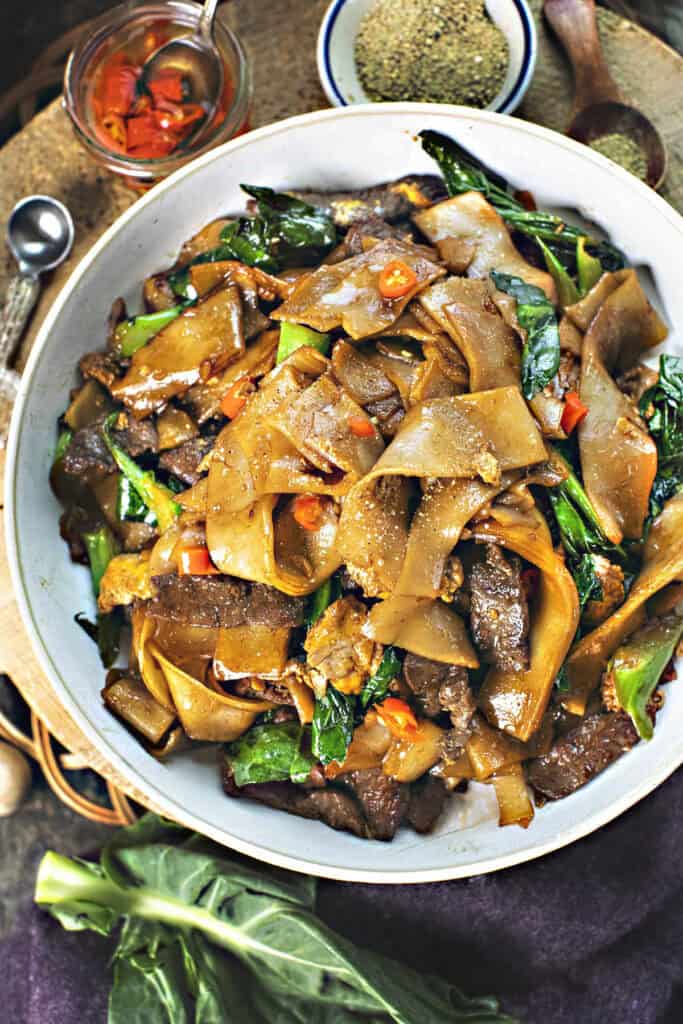
How to Serve Beef Pad See Ew
Beef Pad See Ew is a complete one-dish meal, but it also works beautifully as part of a family-style dinner. Serve it alongside dishes like stir fry cabbage, pineapple fried rice, or duck curry for a well-rounded Thai meal. Enjoy it straight from the wok for an authentic experience, or plate it beautifully for a more formal setting.
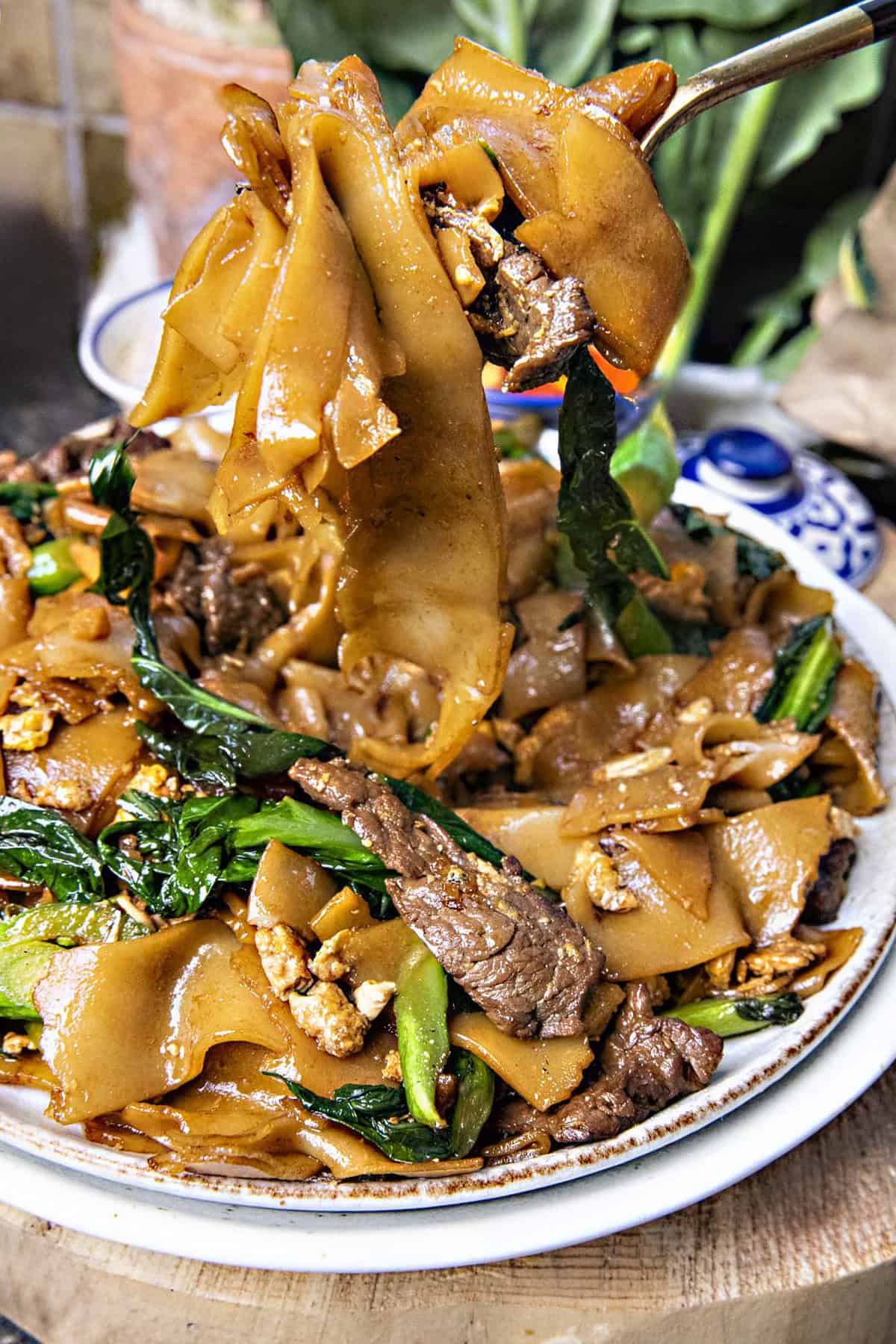
Kitchen Tips
- Use Fresh Rice Noodles. The best option is uncut, wide rice noodle sheets folded into packets (found in Asian markets). You can cut them to your desired width, and they cook quickly with superior texture.
- Dry Rice Noodles. If fresh noodles aren’t available, use the widest dry rice noodles you can find at the Asian market and soak them in hot or warm water per the package instructions. Keep in mind that wider noodles need a longer soak.
- Make Your Own Rice Noodles. They’re easier than you think! Check out my simple Sen Yai recipe, perfect for other Thai dishes like drunken noodles or boat noodles soup.
- Prep Chinese Broccoli. Slice thick stems thinly for even cooking and leave leaves long; they’ll wilt into bite-sized pieces in the wok.
- Use Authentic Thai Brands. For genuine flavor, choose authentic Thai soy sauce, oyster sauce, and fish sauce. My favorites are linked in the recipe card below.
- Cook Beef to Your Preference. Beef cooks faster than chicken or pork. Sear it until lightly charred, even if it’s still a bit rare.
- Slice Beef Thinly. Long, thin slices cook quickly and stay tender.
- Avoid Overcrowding. Work in batches so noodles and ingredients get proper high-heat contact, unlocking that coveted wok hei flavor.
Best Types of Noodles for Pad See Ew
Wide rice noodles are essential for this dish. It's the key ingredient besides the sauce that makes this delicious. Look for fresh or dried wide rice noodles at Asian grocery stores. Fresh, wide rice noodles provide a softer texture, while dried rice noodles offer a chewier bite once soaked.
However, if wide fresh rice noodles are not possible, use wide dry rice noodles as prepared per package instructions.
Best Types of Beef for Pad See Ew
Flank steak is a great go-to because it’s both tender and flavorful. Sirloin, ribeye, or thinly sliced brisket work just as well. Want to save time? Grab pre-sliced stir-fry steak, and you’re good to go!
Pad See Ew vs. Pad Thai
While both are delicious Thai noodle dishes, Pad See Ew uses wide rice noodles and has a slightly sweeter, richer flavor compared to the tangy and often peanut-topped Pad Thai. Pad See Ew focuses on soy and oyster sauces, whereas Pad Thai incorporates tamarind and often includes crushed peanuts.
Storing Leftovers
Store leftover Beef Pad See Ew in an airtight container in the fridge for up to 3 days. Reheat gently in a skillet or microwave, adding a splash of water or soy sauce to moisten if the noodles have dried out. The flavors will meld even more after a day in the fridge!
More Thai Recipes You'll Love
- Kua Gai
- Kua Mee
- Easy Pad Thai without tamarind
- Spaghetti Pad See Mao
- Thai red curry with vermicelli noodles
- Goong Ob Woon Sen
Frequently Asked Questions
Absotlutely! You can make the sauce up to 4 days ahead of time, and be sure to store them in the refrigerator after.
If you can't find wide rice noodles, you can use any rice noodles, flat egg noodles, or glass noodles. However, the texture will differ slightly from traditional Thai rice noodles.
Both dishes can be healthy, but Pad See Ew often uses fewer ingredients and less sugar, making it a slightly healthier option. However, it depends on the specific recipe and portion sizes.
More Thai Rice Noodles Recipes
Looking for other recipes like this? Try these:
**Love a recipe you've tried? Please leave a 5-star rating in the recipe card below and a review in the comments section further down the page. Or follow me on Facebook, Pinterest, or Instagram!**
Print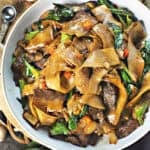
Easy Beef Pad See Ew Recipe
- Total Time: 25 minutes
- Yield: 4 servings
- Diet: Low Lactose
Description
Get dinner on the table in just 30 minutes with this easy, authentic Beef Pad See Ew! Tender marinated beef, chewy-silky rice noodles, and a sweet-savory sauce all come together in a sizzling stir-fry that brings real Thai flavor straight to your plate.
Ingredients
For the Sauce:
- 2 tbsp Thai oyster sauce (Mae Krua brand)
- 1 tbsp Thai light soy sauce
- 2 tbsp Thai dark soy sauce (add 1 more tablespoon if you prefer darker noodles)
- 2 tbsp Golden Mountain seasoning sauce (or Maggi)
- 1 tbsp Thai fish sauce (Squid brand, premium)
- 2 tbsp sugar (white or brown)
- ½ tsp ground white pepper
For the Stir-Fry:
- 8 oz beef flank steak, thinly sliced into long strips
- 1 lb fresh wide rice noodles (see Notes for dry noodle substitute)
- 2 tbsp garlic, finely chopped
- 3 tbsp oil, divided (vegetable, rice bran, or avocado oil)
- 2 eggs
- 5 oz Chinese broccoli (about 3–4 stems), stems sliced thin, leaves cut into 4–5 inch pieces
Garnish (Optional):
- Extra ground white pepper
- Thai chili vinegar (Prik Nam Som) or regular vinegar
- Chili flakes
Instructions
1. Make the Sauce
In a small bowl, mix oyster sauce, light soy, dark soy, Golden Mountain sauce, fish sauce, sugar, and white pepper. Stir well and set aside.
2. Marinate the Beef
Place sliced beef in a bowl and add 1½ tablespoons of the prepared sauce. Mix well and set aside to marinate while you prep the rest.
3. Prepare the Noodles
-
If using fresh wide rice noodles: Cut into 2-inch strips, then microwave for 2–3 minutes to soften. Gently separate while warm.
-
If using dry rice noodles: Soak in hot water until just pliable (or follow package directions), then drain and set aside.
4. Stir-Fry the Beef
Heat 1 tablespoon of oil in a wok over medium-high heat. Add chopped garlic and stir-fry for 10 seconds, then add the marinated beef. Cook for 1 minute until mostly browned (it’ll finish cooking later). Push to one side of the wok.
5. Add the Eggs
Add another tablespoon of oil to the empty side of the pan. Crack in two eggs and scramble until softly set.
6. Add the Chinese Broccoli
Toss in the stems and leaves, cooking for about 2 minutes. The stems should be just tender and the leaves wilted.
7. Add the Noodles and Sauce
Add noodles and pour in the remaining sauce—drizzle it evenly over the pan instead of in one spot to avoid mushy noodles. Toss everything together quickly over high heat until well coated and slightly charred (wok hei).
8. Finish and Serve
Turn off the heat. Serve hot and garnish with white pepper, chili flakes, and vinegar if desired.
Notes
- Use Fresh Noodles When Possible: Uncut rice noodle sheets give the best texture. Found in the refrigerated section at Asian markets. Or use my homemade Sen Yai recipe.
- No pooling of sauce: When adding the sauce in step 7, drizzle it evenly over the noodles and other ingredients instead of pouring it all in one spot. This helps the sauce coat everything evenly and prevents it from pooling, which can lead to soggy noodles—a common issue I see often in cooking classes.
- Stick to One Batch: For the best texture and flavor, it's best to follow the measurements in this recipe and cook one batch at a time. Pad See Ew needs a little breathing room in the wok to get that perfect char—cooking too much at once can make it steam instead of stir-fry.
- Heat Management: Use medium-high heat but be quick. Once the broccoli and noodles are in, lower the heat for 1–2 minutes to release moisture, then crank it back up to finish.
- Beef Cuts & Slicing: Flank steak works great. Slice against the grain into long, thin strips for tenderness.
- Dark Soy Sauce Warning: Thai dark soy is sweet and mellow, while Chinese black soy is saltier and smokier. They are not interchangeable—see my photos in the post for brand reference.
- Prep Time: 15 minutes
- Cook Time: 10 minutes
- Category: Thai noodles
- Method: Stir-frying
- Cuisine: Thai

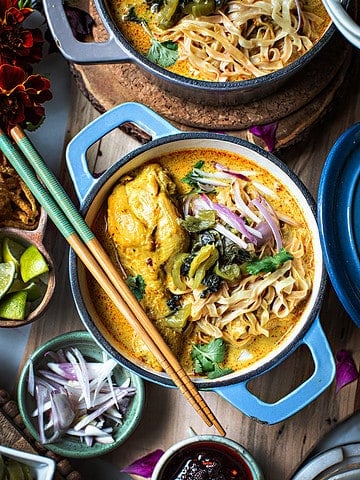
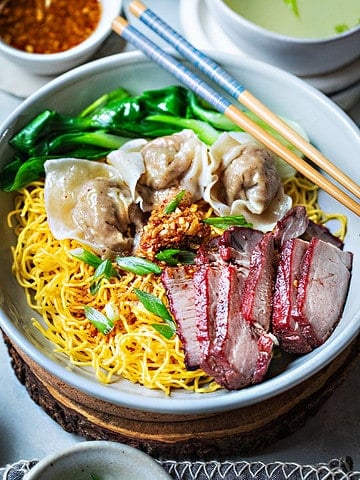
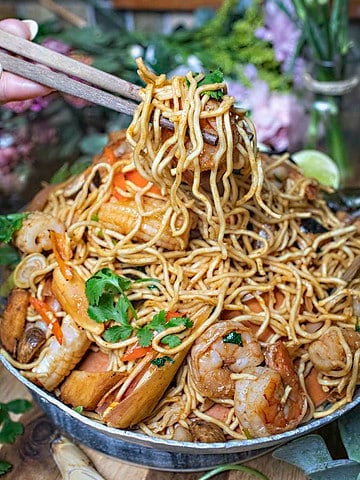
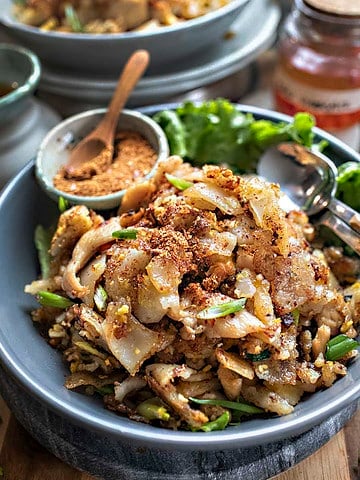
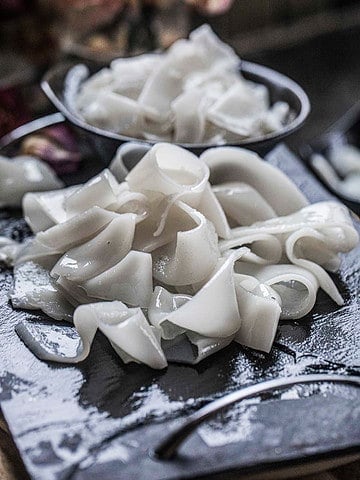
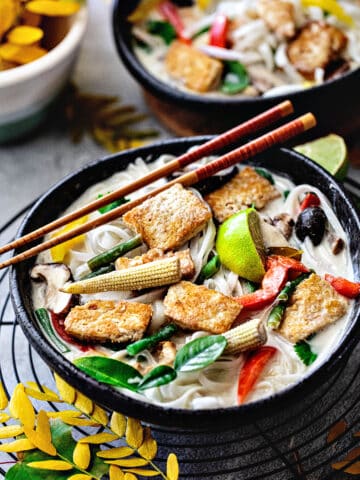


Trish says
Saw on another recipe that when substituting Chinese dark soy sauce for black soy sauce to not use the golden mountain because the Chinese dark soy sauce is much saltier than Thai black soy sauce. Maybe that is what went wrong when I tried the recipe, as I only had Chinese dark soy sauce? Maybe a note clarifying that or an adjustment would be helpful! Thank you!
Trish says
Looking forward to seeing if your recipe ends up with any adjustments that I can try next time. "Soupy" was probably a bit of an exaggeration and it's probably more a ratio issue with the ingredients than an amount of sauce issue. As noted elsewhere, I did double this recipe when making it (and if anything, threw in extra beef). Used a whole package of 1 lb fresh wide rice noodles and 1.1 lbs of flank steak along with double the gai lan. Thank you for getting back to my comment so quickly and taking a look at whether some adjustments might help!
Suwanee says
Thank you for your thoughtful feedback, Tris. I’m sorry it turned out too salty and soupy—that’s not how this dish should be. I’ll be retesting the recipe soon and reviewing the sauce measurements closely, especially the teaspoons vs. tablespoons. My goal is to share an authentic Thai-style Pad See Ew, and your input helps me improve it. I appreciate you taking the time to share!
Trish says
Hi I made this recipe and really appreciated your tips about how to deal with the fresh wide rice noodle. Unfortunately it was almost inedibly salty and was almost soupy. Now that I compare it with other pad see ew recipes it uses way more sauce than the others which are often measured in teaspoons-wondering if maybe there was a mixup in your recipe of teaspoons and tablespoons at some points? Other than the salt level it was good. I frequently get pad see ew and love it and haven’t had this problem with restaurant ones so I don’t think it’s me being sensitive to salt. Everyone in the family thought it was too salty. Hoping you can adjust as otherwise recipe was good, thank you!